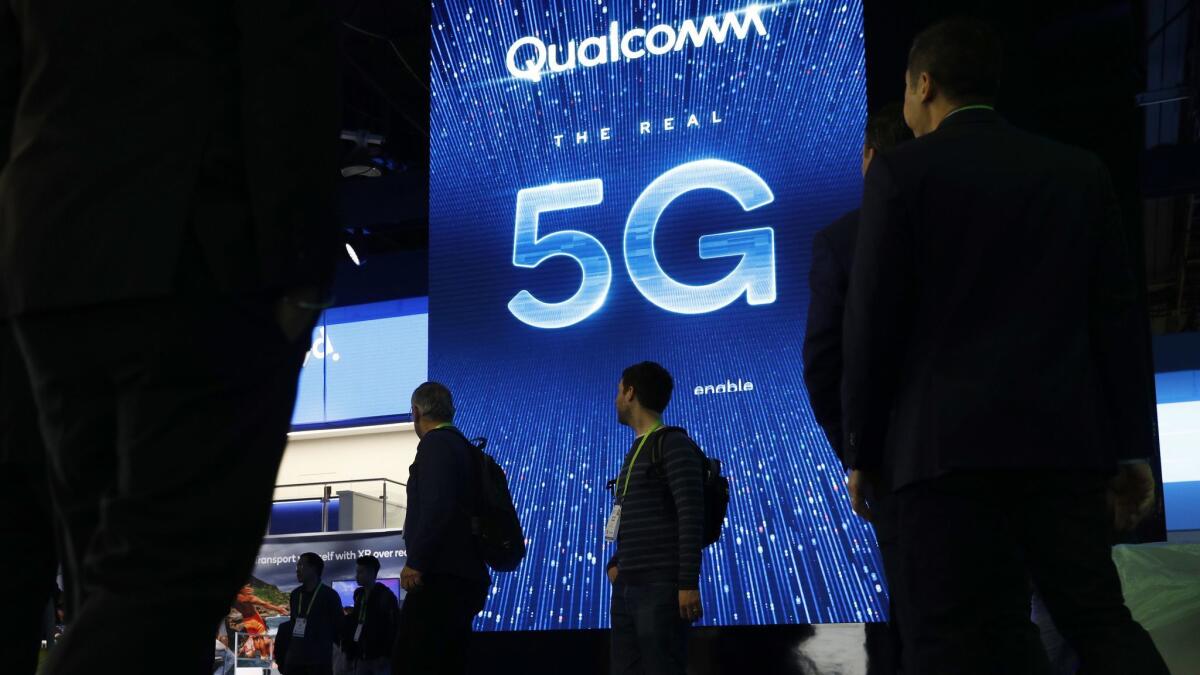U.S. has early lead in 5G tech despite concerns about competition from China, report says

- Share via
The race to 5G wireless tech is on. A report finds Americans have an early lead.
U.S. policymakers keep wringing their hands over a competition with China to build the world’s first mass-market 5G wireless network. But a new report from Cisco may offer reasons to breathe easier.
By 2022, fifth-generation cellular networks will power as much as 9% of mobile data connections across North America, Cisco said, compared with 4% in Asia. The new projections were unveiled Tuesday as part of Cisco’s annual mobile Visual Networking Index report, which studies industry trends.
The results underscore the substantial work countries like China face as they race Western nations to build the systems. And they reflect early U.S. policies that put it in a strong position to lead, said Cisco, which makes networking technology.
The technology is expected to offer far faster download speeds than currently available, reducing, for example, the time it takes to get a movie from several minutes to just seconds. And, proponents say, 5G’s reliability will unlock new capabilities such as self-driving cars, remote medicine and a thriving ecosystem of smart appliances that require a constant connection.
Although the Asia-Pacific region will be home to more than twice the number of 5G devices in North America by 2022, it will account for a tiny share of the 422 million devices on 5G worldwide, according to Cisco. North America will account for the largest slice; most of the rest, about 6.5%, will come from Western Europe.
Tuesday marks the first time Cisco has dedicated an entire section in its mobile report to 5G technology.
“The U.S. has made a good start in changing policies to support the deployment of 5G, and as we look around the rest of the world, policy changes of the type we’ve seen here in the U.S. have not yet happened,” said Mary Brown, senior director of government affairs at Cisco. “We do expect that’s going to be changing over the next 12 to 18 months, and so the race to 5G is very real.”
A head start in 5G penetration could be critical for determining which countries get to shape — and benefit from — innovations in apps, services and other economic fruits of the technology, according to policy analysts. When the United States took the lead on 4G mobile technology, it gave rise to the app economy, which remains dominated by U.S.-based firms today, Brown said.
“The stakes with 5G are even higher,” she said.
For now, a true 5G experience remains out of reach for the average consumer. The first 5G smartphones aren’t expected until later this year; in the meantime, carriers such as AT&T and Verizon have been locked in a marketing war to persuade customers that they’re making rapid progress — with AT&T recently being sued for some of its promotional activities.
Telecom executives, and many federal officials, have cited intense competition with global rivals as a reason to accelerate the spread of 5G in the United States with deregulation and policies favorable to the industry.
“U.S. leadership in 5G technology is a national imperative for economic growth and competitiveness,” said Ajit Pai, chairman of the Federal Communications Commission, at a White House summit on the issue last year. “We cannot let today’s red tape strangle the 5G future.”
Last year, in a bid to grease processes at the local level, the FCC moved to limit how much cities could charge telecom companies for using publicly owned utility poles, and it required swifter decisions on infrastructure permits. The plan was welcomed by industry groups as a crucial step toward building 5G, but it was assailed by other critics who said it amounted to a massive corporate handout.
“This effectively transfers $2 billion from cities to carriers,” wrote Blair Levin, a former FCC chief of staff, in a blog post this week. “In return, the FCC asks carriers for nothing.”
Complicating the picture are ongoing concerns about the security of networking equipment from companies such as China’s Huawei, which the Trump administration is expected to target with an executive order.
The FCC, in a separate move, has proposed limiting federal funding to U.S. telecom companies that use Huawei’s hardware. Policymakers worry that foreign manufacturers could secretly install spyware in their products that could allow other governments to eavesdrop on sensitive U.S. communications. Huawei’s founder on Tuesday rejected those claims as speculation in an interview with CBS.
The report notes that the uncertainty surrounding U.S. infrastructure policy, Washington’s stance on foreign firms and the details of 5G technology that are still being hammered out could result in delays.
“We anticipate that some large scale commercial 5G deployments may not be executed until after the current forecast period” after 2022, Cisco said in its report.
But even after considering those factors, North America will still wind up ahead of the competition in 5G penetration by 2022, the report concluded.
Fung writes for the Washington Post.






